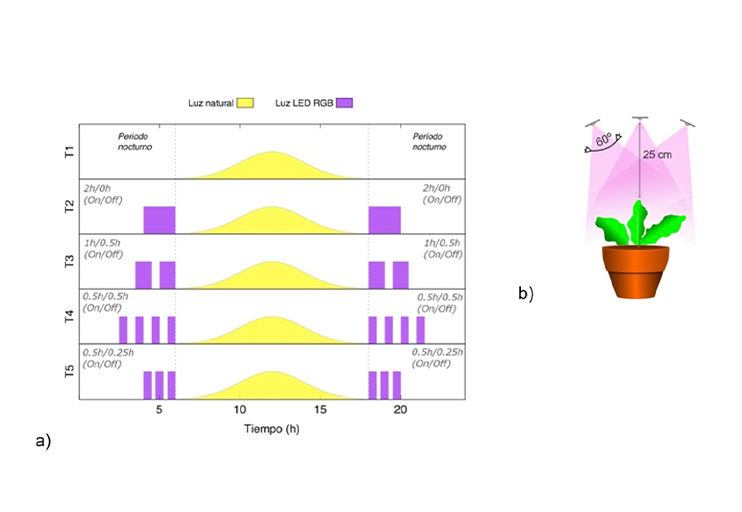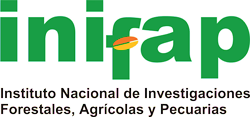Effect of supplementary pulsed LED light on lettuce growth under a greenhouse
DOI:
https://doi.org/10.29312/remexca.v16i30.4044Keywords:
Lactuca sativa L., energy saving, greenhouse, photoperiod, photosynthesisAbstract
The intermittent LED light with short on/off pulses as a source of supplementary light to sunlight could promote greater vegetable growth with a consequent lower energy consumption; nevertheless, its effect on lettuce (Lactuca sativa L.) under greenhouse conditions has been little studied. The work evaluated how different regimes of pulsed LED light affect the photosynthetic rate, stomatal conductance, leaf area, and fresh and dry weight, considered plant growth parameters. These parameters were analyzed under a completely randomized experimental design, establishing five treatments, with a total of 8 plants grown per treatment, applying LED light on them as a source of supplementary light to sunlight at night. The results indicated that the pulsed LED light with short on/off periods (30/15 min) does not produce significant differences (Anova, p> 0.05) in photosynthetic rates, stomatal conductance, and fresh or dry weight between the supplementary pulsed and continuous LED light. The pulsed light (30/15 min) produces a statistically significant increase (Anova, p= 7.15x10-5) in terms of leaf area compared to the continuous LED light, allowing a 25% reduction in the operating time of the lighting system without negatively affecting this parameter.
Downloads
References
Ali, A.; Santoro, P.; Ferrante, A. and Cocetta, G. 2023. Investigating pulsed LED effectiveness as an alternative to continuous LED through morpho-physiological evaluation of baby leaf lettuce (Lactuca sativa L. var. Acephala). South African Journal of Botany. 160(3):560-570.
Ali, A.; Santoro, P.; Ferrante, A. and Cocetta, G. 2024. Continuous and pulsed LED applications on red and green lettuce (Lactuca sativa L. var. capitata) for pre- and post-harvest quality and energy cost assessments. Sci Hortic. 338:1-24.
Avgoustaki, D. D.; Bartzanas, T. and Xydis, G. 2021. Minimising the energy footprint of indoor food production while maintaining a high growth rate: introducing disruptive cultivation protocols. Food Control. 130:1-13.
Boros, I. F.; Székely, G.; Balázs, L.; Csambalik, L. and Sipos, L. 2023. Effects of LED lighting environments on lettuce (Lactuca sativa L.) in PFAL systems a review. Sci Hortic. 321:1-19.
Burattini, C.; Mattoni, B. and Bisegna, F. 2017. The impact of spectral composition of white leds on spinach (Spinacia oleracea) growth and development. energies (basel). 10(9):1-14.
Chen, X. L. and Yang, Q. C. 2018. Effects of intermittent light exposure with red and blue light emitting diodes on growth and carbohydrate accumulation of lettuce. Sci Hortic. 234:220-226.
Chen, X. L; Yang, Q. C.; Song, W. P.; Wang, L. Ch.; Guo, W. Z. And Xue, X. Z. 2017. Growth and nutritional properties of lettuce affected by different alternating intervals of red and blue LED irradiation. Sci. Hortic. 223:44-52. https://doi.org/10.1016/j.scienta.2017.04.037.
Chinchilla, S; Izzo, L. G.; Van-Santen, E. and Gómez, C. 2018. Growth and physiological responses of lettuce grown under pre-dawn or end-of-day sole-source light-quality treatments. Horticulturae. 4(2):1-10.
Dutta-Gupta, S. 2017. Light emitting diodes for agriculture: smart lighting. In light emitting diodes for agriculture: smart lighting. 1st. Ed. 113-147 pp. Springer. https://doi.org/10.1007/978-981-10-5807-3
He, D.; Kozai, T.; Niu, G. and Zhang, X. 2019. Light-emitting diodes for horticulture bt - light-emitting diodes: materials, processes, devices and applications. In: Li, J. and Zhang, G. Q. Ed. Springer International Publishing, Cham. 513-547 pp.
Jishi, T. 2018. LED lighting techniques to control plant growth and morphology. In: smart plant factory: the next generation indoor vertical farms. 211-222 pp.
Jishi, T.; Kimura, K.; Matsuda, R. and Fujiwara, K. 2016. Effects of temporally shifted irradiation of blue and red LED light on cos lettuce growth and morphology. Sci Hortic. 198:227-232.
Nissim-Levi, A.; Kitron, M.; Nishri, Y.; Ovadia, R.; Forer, I. and Oren-Shamir, M. 2019. Effects of blue and red LED lights on growth and flowering of Chrysanthemum morifolium. Sci Hortic. 254:77-83.
Ohtake, N.; Ishikura, M.; Suzuki, H.; Yamori, W. and Goto, E. 2018. Continuous irradiation with alternating red and blue light enhances plant growth while keeping nutritional quality in lettuce. HortScience. 53(12):1804-1809.
R Core Team, 2023. R: a language and environment for statistical computing (4.2.3) R. Foundation for Statistical Computing. https://www.r-project.org/,
Radetsky, L.; Patel, J. S. and Rea, M. S. 2020. Continuous and intermittent light at night, using red and blue LEDs to suppress basil downy mildew sporulation. Hort. Science. 55(4):483-486.
Reis, M. G. and Ribeiro, A. 2020. Conversion factors and general equations applied in agricultural and forest meteorology. Agrometeoros. 27:227-258.
Sullivan, G. M. and Feinn, R. 2012. Using effect size or why the P value is not enough. J. Grad. Med. Educ. 4(3):279-282.
Tewolde, F. T.; Lu, N.; Shiina, K.; Maruo, T.; Takagaki, M.; Kozai, T. and Yamori, W. 2016. Nighttime supplemental LED inter-lighting improves growth and yield of single-truss tomatoes by enhancing photosynthesis in both winter and summer. Front Plant Sci. 7:1-10. https://doi.org/10.3389/fpls.2016.00448.
Viršilė, A.; Brazaitytė, A.; Vaštakaitė-Kairienė, V.; Miliauskienė, J.; Jankauskienė, J.; Novičkovas, A.; Laužikė, K. and Samuolienė, G. 2020. The distinct impact of multi color LED light on nitrate, amino acid, soluble sugar and organic acid contents in red and green leaf lettuce cultivated in controlled environment. Food Chem. 310:1-9.
Yang, J.; Song, J. and Jeong, B. R. 2022. Lighting from top and side enhances photosynthesis and plant performance by improving light usage efficiency. International Journal of Molecular Sciences. 23(5):1-25. https://doi.org/10.3390/ijms23052448.

Published
How to Cite
Issue
Section
License
Copyright (c) 2025 Revista Mexicana de Ciencias Agrícolas

This work is licensed under a Creative Commons Attribution-NonCommercial 4.0 International License.
The authors who publish in Revista Mexicana de Ciencias Agrícolas accept the following conditions:
In accordance with copyright laws, Revista Mexicana de Ciencias Agrícolas recognizes and respects the authors’ moral right and ownership of property rights which will be transferred to the journal for dissemination in open access. Invariably, all the authors have to sign a letter of transfer of property rights and of originality of the article to Instituto Nacional de Investigaciones Forestales, Agrícolas y Pecuarias (INIFAP) [National Institute of Forestry, Agricultural and Livestock Research]. The author(s) must pay a fee for the reception of articles before proceeding to editorial review.
All the texts published by Revista Mexicana de Ciencias Agrícolas —with no exception— are distributed under a Creative Commons License Attribution-NonCommercial 4.0 International (CC BY-NC 4.0), which allows third parties to use the publication as long as the work’s authorship and its first publication in this journal are mentioned.
The author(s) can enter into independent and additional contractual agreements for the nonexclusive distribution of the version of the article published in Revista Mexicana de Ciencias Agrícolas (for example include it into an institutional repository or publish it in a book) as long as it is clearly and explicitly indicated that the work was published for the first time in Revista Mexicana de Ciencias Agrícolas.
For all the above, the authors shall send the Letter-transfer of Property Rights for the first publication duly filled in and signed by the author(s). This form must be sent as a PDF file to: revista_atm@yahoo.com.mx; cienciasagricola@inifap.gob.mx; remexca2017@gmail.
This work is licensed under a Creative Commons Attribution-Noncommercial 4.0 International license.


